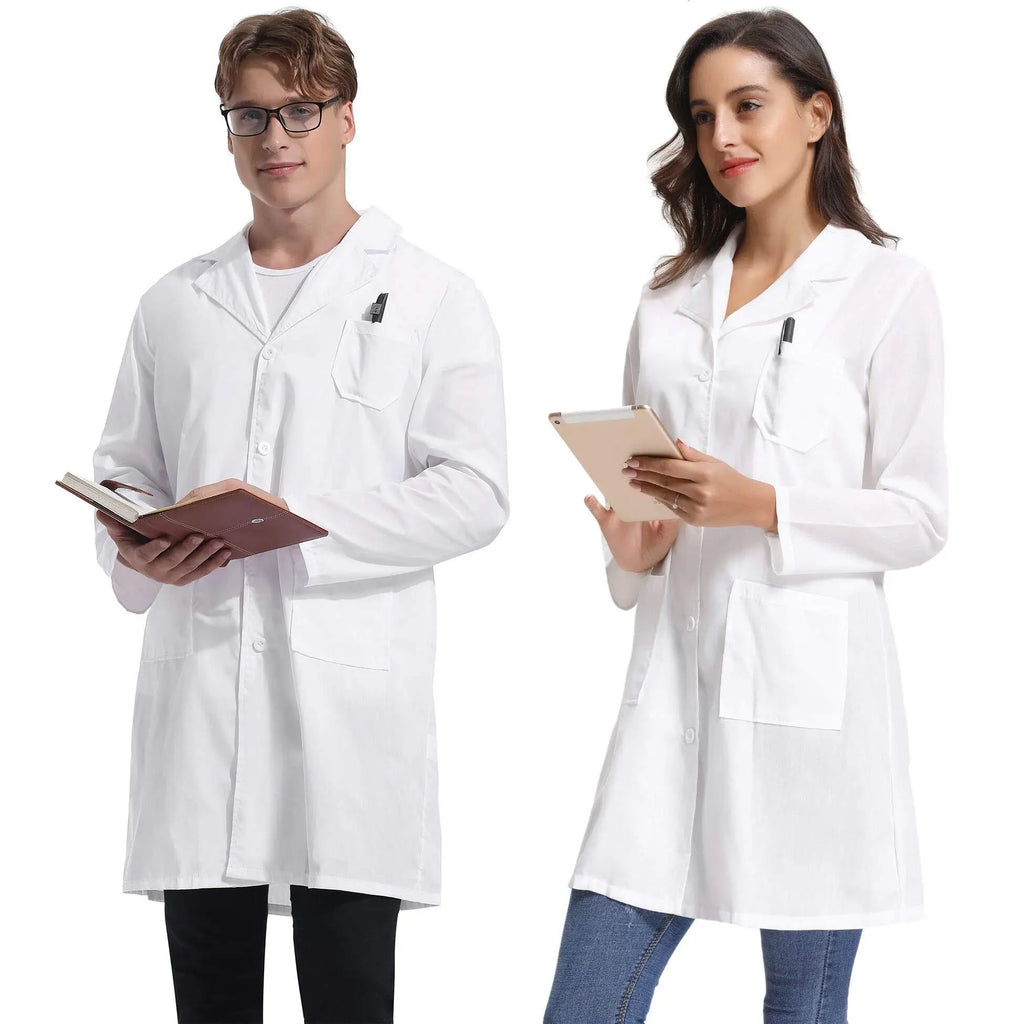Best Fabric For Lab Coat

When selecting the best fabric for lab coat, it’s not just about appearance, it’s about comfort, protection, and durability. Whether you're a student just starting your journey or a seasoned healthcare professional, the fabric you choose directly affects your performance and safety. With several options on the market—like the breathable Cotton Lab Coat, the flame-resistant Nomex Lab Coat, or the wrinkle-resistant Polyester Lab Coat—it’s important to understand what suits your daily needs. In this guide, we’ll explore the top lab coat fabric materials, their benefits, and how to make the right choice for your role.
What's the Purpose of a Lab Coat?
A lab coat is more than just a uniform, it’s a critical layer of protection and professionalism in medical, research, and educational environments. Whether you're wearing a Cotton Lab Coat in a university lab or a Nomex Lab Coat in a high-risk chemical setting, the purpose of this garment goes far beyond aesthetics.
Key Purposes of a Lab Coat:
-
Protection: Shields against spills, splashes, and contaminants. The best fabric for lab coat selection plays a vital role in this—flame-resistant fabrics like Nomex offer enhanced safety in hazardous conditions.
-
Professional Identity: Instantly signifies a role in science, healthcare, or education, especially when customized to the workplace’s standards.
-
Functionality: Designed with pockets for convenience, ideal for tools, pens, or instruments, making it practical for daily tasks.
-
Hygiene & Safety Compliance: Helps maintain sterile environments and reduces the spread of contaminants between spaces.
-
Fabric Flexibility: Different lab coat fabric materials like Cotton, Polyester, or blended fabrics allow users to choose based on comfort, breathability, and resistance needs. For example, a Polyester Lab Coat may offer wrinkle resistance, while a Cotton Lab Coat provides softness and airflow for long hours of wear.
Choosing the right coat and more importantly, the best fabric for lab coat—ensures you're protected, comfortable, and compliant with your work environment’s demands.
Related articles: How to choose a lab coat?
Fabric Types (pros and cons)

Choosing the best fabric for lab coat depends on balancing protection, comfort, cost, and maintenance. Each lab coat fabric material offers unique features that cater to different professional settings—from basic labs to high-risk environments. Let’s break down the pros and cons of the most common fabrics:
1. Cotton Lab Coat
Pros:
-
Breathable and comfortable for long wear
-
Hypoallergenic and gentle on the skin
-
Easy to wash and dye
Cons:
-
Wrinkles easily
-
May shrink after washing
-
Offers minimal resistance to fluids and chemicals
2. Polyester Lab Coat
Pros:
-
Wrinkle-resistant and low-maintenance
-
Durable and long-lasting
-
Retains shape and color over time
Cons:
-
Less breathable than cotton
-
Can retain heat and feel less comfortable in warm environments
3. Polyester/Cotton Blend
Pros:
-
Combines the breathability of cotton with the durability of polyester
-
More wrinkle-resistant than 100% cotton
-
Budget-friendly and widely used in lab coats for students
Cons:
-
Less soft than pure cotton
-
May still lack high-level chemical resistance
4. Nomex Lab Coat
Pros:
-
Excellent flame and heat resistance
-
Durable in extreme environments
-
Ideal for chemical, electrical, or high-temperature labs
Cons:
-
More expensive than standard fabrics
-
Less comfortable and breathable
-
Not typically used for general medical settings
5. Polypropylene Lab Coat
Pros:
-
Lightweight and disposable
-
Offers good barrier protection against fluids
-
Used in sterile and short-term environments
Cons:
-
Not reusable or durable
-
Limited breathability and comfort
-
Not suitable for long-term or high-contact use
6. Nylon Blend Lab Coat
Pros:
-
Strong and resistant to wear and tear
-
Water-resistant properties
-
Often used in hybrid applications
Cons:
-
Less breathable than cotton
-
May not offer sufficient chemical protection
-
Can feel stiff depending on the blend
7. Modacrylic Lab Coat
Pros:
-
Flame-resistant and self-extinguishing
-
Lightweight and soft
-
Good for electrical and flame-risk environments
Cons:
-
Higher cost than common fabrics
-
Limited availability
-
May not withstand heavy-duty lab use
8. Rayon Lab Coat Blends
Pros:
-
Smooth, breathable, and comfortable
-
Often blended to improve softness
-
Better drape and fit compared to stiff fabrics
Cons:
-
Not durable on its own; often blended with other fibers
-
Can shrink or weaken with frequent washing
-
Not chemical-resistant
By understanding the pros and cons of each fabric, you can better identify the best fabric for lab coat based on your specific role and environment—whether you need the breathability of a Cotton Lab Coat, the toughness of a Nomex Lab Coat, or the practicality of a Polyester Lab Coat.
Related articles: Lab Coat VS Medical Coat
Factors to consider when buying a lab coat
Choosing the best fabric for lab coat isn’t just about picking what looks good. The right lab coat plays a critical role in your daily performance, comfort, and safety. Below are the key factors to evaluate when selecting a lab coat fabric material and design that best suits your needs.
1. Durability
A lab coat should withstand repeated use and laundering without fading, tearing, or losing shape. Polyester Lab Coats and Polyester/Cotton blends are known for their durability, while Cotton Lab Coats offer less resistance to wear but more comfort. For harsh environments, Nomex Lab Coats are unmatched in long-term durability.
2. Protection
Consider your workplace risks. Do you deal with chemicals, fire, or biohazards? For basic protection, a Cotton Lab Coat may suffice. If you're working in high-risk environments, flame-resistant options like Nomex Lab Coats or fluid-resistant Polypropylene coats are ideal. The best fabric for lab coat in such settings should provide both physical and chemical protection.
3. Maintenance and Care
How often will you wash your lab coat? If easy care is a priority, Polyester Lab Coats are wrinkle-resistant and dry quickly. Cotton Lab Coats, on the other hand, may require ironing and are prone to shrinking. Choose a lab coat fabric material that aligns with your lifestyle and time constraints.
4. Style and Aesthetics
A lab coat should reflect professionalism, but style matters too. Consider fit, length, sleeve style, and collar shape. Some blends, like Rayon or Modacrylic blends, offer a softer drape and modern silhouette, which is great for those who want a more tailored look without sacrificing function.
5. Cost vs. Quality
Budget matters, especially for students or interns. While Polyester/Cotton blends are cost-effective and widely used in lab coats for students, professionals may opt for higher-end materials like Nomex for enhanced safety. Evaluate if the added cost brings proportional benefits in durability and protection.
6. Fabric Technologies
Some modern lab coats come with anti-microbial finishes, stain-resistant coatings, or moisture-wicking features. These fabric technologies can significantly enhance comfort and hygiene, especially in long shifts or clinical environments.
By carefully considering these factors, you’ll be better equipped to choose the best fabric for lab coat that balances comfort, protection, and professional appearance—whether it's a breathable Cotton Lab Coat, a sturdy Polyester Lab Coat, or a specialized Nomex Lab Coat
Best fabric for lab coat

When choosing the best fabric for lab coat, it's essential to consider both the purpose of the coat and the environment in which it will be used. Different lab coat fabric materials offer varying degrees of comfort, durability, and protection, making some more suitable for clinical settings and others for laboratory or industrial environments.
Here are some of the most popular and effective fabric options:
1. Cotton Lab Coat
Pros:
-
Breathable and comfortable for long wear
-
Natural fiber with good moisture absorption
-
Ideal for warmer climates or sensitive skin
Cons:
-
Prone to wrinkling and shrinking
-
May not provide strong chemical or flame resistance
Cotton is a classic choice for those seeking comfort, especially in educational or light-duty healthcare environments.
2. Polyester Lab Coat
Pros:
-
Durable and resistant to shrinking or wrinkling
-
Low maintenance and quick-drying
-
Holds its shape over time
Cons:
-
Less breathable than cotton
-
May not be comfortable in hot environments
Polyester is widely used in professional settings due to its strength and easy care, making it a reliable lab coat fabric material for daily use.
3. Polyester/Cotton Blend
Pros:
-
Combines comfort of cotton with durability of polyester
-
More wrinkle-resistant than pure cotton
-
Cost-effective and widely available
Cons:
-
May not offer high protection in hazardous environments
Blended fabrics are popular for lab coats for students and general practitioners who need a balance of comfort and resilience.
4. Nomex Lab Coat
Pros:
-
Flame-resistant and suitable for high-risk environments
-
High durability under intense conditions
-
Offers excellent chemical protection
Cons:
-
More expensive than standard fabrics
-
Less breathable compared to cotton
Nomex Lab Coats are the top choice in environments requiring fire safety, such as chemical labs or industrial facilities.
5. Polypropylene Lab Coats
Pros:
-
Lightweight and disposable
-
Fluid-resistant and protective against light contamination
Cons:
-
Not reusable or long-lasting
-
Limited breathability and style
Ideal for temporary use or high-contamination areas where safety is prioritized over aesthetics.
6. Other Specialty Fabrics
-
Nylon Blends: Strong and water-resistant, often used in technical environments
-
Modacrylic: Offers flame resistance with a softer texture
-
Rayon Blends: Lightweight and comfortable, but less durable over time
The best fabric for lab coat depends on your professional needs, budget, and workplace hazards. For comfort, a Cotton Lab Coat is ideal. For durability and easy maintenance, a Polyester Lab Coat or blend works best. If protection is the priority, especially against fire or chemicals, then a Nomex Lab Coat is the clear winner.
Related articles: How to Disinfect Lab Coats?
Why to Choose Medical Outfit?
When it comes to choosing a lab coat for doctors, a medical coat for clinical professionals, or even a lab coat for students, quality, reliability, and comfort are non-negotiable. That’s where Medical Outfit stands out.
Medical Outfit is known for offering premium lab coat fabric material that meets the demands of both professional and academic environments. Whether you're in a hospital, laboratory, or classroom, choosing Medical Outfit ensures you're getting garments designed for durability, protection, and style.
Here’s why professionals trust Medical Outfit:
-
High-Quality Fabrics: From 100% breathable cotton to advanced blends and flame-resistant options like Nomex lab coats, Medical Outfit ensures every material is selected for comfort and performance.
-
Exceptional Craftsmanship: Every lab coat or medical coat is tailored with attention to detail—from reinforced seams to well-fitted designs—making them suitable for long shifts and high-demand settings.
-
Functional Design: Practical features like easy-access pockets, fluid resistance, and smart fits ensure you're both protected and presentable at all times.
-
Affordable Options: Whether you're comparing the lab coat vs medical coat cost or shopping for a student on a budget, Medical Outfit offers competitive prices without compromising quality.
Choosing Medical Outfit means investing in a product that delivers protection, comfort, and professional appeal whether you're a student just starting out or a doctor leading the way.
In the end, the best fabric for lab coat depends on your work environment, comfort preferences, and the level of protection you need. A Cotton Lab Coat offers softness and breathability, while a Nomex Lab Coat provides exceptional fire resistance. On the other hand, a Polyester Lab Coat ensures durability and minimal maintenance. By understanding the unique qualities of each lab coat fabric material, you can make an informed choice that supports your daily routine and keeps you safe. No matter your role, the right fabric makes all the difference.
Related articles: Do Doctors Wear Lab Coats?
Frequently Asked Questions
-
What Type of Footwear is Best for the Laboratory?
In any laboratory setting, safety and comfort are essential. Footwear plays a critical role in protecting lab personnel from chemical spills, broken glass, and other physical hazards. The best footwear for the lab complements other protective gear like the lab coat for doctors or lab coat for students and follows institutional safety protocols.
Recommended Footwear:
-
Closed-toe shoes: Absolutely essential. Open-toe shoes are strictly prohibited in most labs due to spill and impact risks.
-
Non-slip soles: Reduce the risk of slipping on wet or polished lab floors.
-
Chemical-resistant materials: Shoes made with rubber or coated leather can resist chemical splashes.
-
Supportive, comfortable design: Labs often require long hours of standing. Footwear with cushioned soles and arch support is ideal.
-
No mesh or fabric uppers: These absorb chemicals and offer minimal protection.
Look for closed-toe, slip-resistant, chemical-resistant shoes with good arch support. Safety starts from head to toe, and the right footwear is just as important as choosing the right lab coat fabric material.
What is Laboratory Dress Code?
A laboratory dress code is designed to maintain safety and hygiene, while also fostering professionalism. Whether you’re a student, researcher, or healthcare professional, complying with lab dress codes is non-negotiable.
Key Elements of Lab Dress Code:
-
Lab Coat: A mandatory protective layer. Choose one suited to your environment—such as a Cotton Lab Coat for comfort or a Nomex Lab Coat for high-risk chemical work.
-
Full-length pants: Shorts, skirts, or cropped pants are not allowed as they expose skin to chemical or thermal hazards.
-
Closed-toe footwear: As mentioned, safety shoes are required.
-
Gloves: Depending on the task, chemical-resistant or disposable gloves must be worn.
-
Safety goggles: Protect your eyes from splashes, dust, or fumes.
-
Hair & Accessories: Long hair should be tied back. Jewelry and loose clothing must be avoided.
The lab dress code emphasizes full coverage, chemical resistance, and safety-first design. Just as you would choose the best fabric for lab coat based on your field, your overall lab attire should reflect the same attention to protection and practicality.





